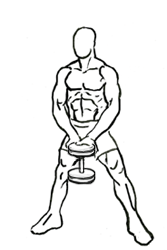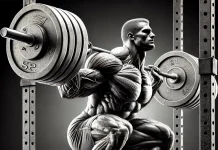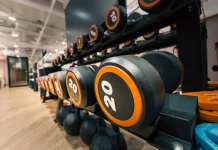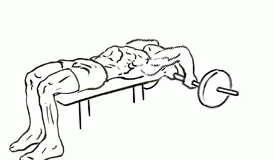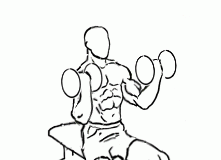Last Updated on November 7, 2024
The Plié Squat with Dumbbell is a powerful lower-body exercise that engages multiple muscles, helping you build strength, tone your legs, and enhance stability. This squat variation, often referred to as a “sumo squat,” is inspired by the ballet plié and is highly effective for targeting the inner thighs, glutes, quads, and hamstrings. It’s an excellent addition to any leg day routine, especially for those looking to add definition to the inner thighs and strengthen the lower body with a core-stabilizing element.
In this guide, we’ll cover everything you need to know about the Plié Squat with Dumbbell, including benefits, detailed instructions, advanced tips, and variations to help you maximize this exercise. Let’s explore how this versatile movement can bring you closer to a strong, sculpted lower body.
Why the Plié Squat with Dumbbell?
The Plié Squat with Dumbbell offers a range of benefits, from improving lower body strength to enhancing core stability. Here’s why it’s a must-have in your exercise routine:
- Targeted Inner Thigh Activation: The wide stance of the plié squat specifically targets the inner thigh muscles (adductors), which are often neglected in other exercises.
- Enhanced Glute Engagement: This squat variation recruits the glute muscles, helping to lift and shape the glutes for a balanced lower body.
- Improved Core Stability: Holding a dumbbell in the center of your body engages the core, promoting better posture and stability throughout the movement.
- Leg and Hip Flexibility: The plié squat requires a wide stance and deep squat, promoting flexibility in the hips and strengthening the hip abductors.
- Functional Strength: Building strength in the inner thighs, glutes, and quads supports daily activities like climbing stairs, lifting, and balance.
Anatomy of Muscles Worked in the Plié Squat with Dumbbell
Understanding which muscles are engaged in this exercise will help you focus on the areas being worked:
- Inner Thighs (Adductors): The wide stance and outward toe position place extra emphasis on the inner thigh muscles, helping tone and strengthen this often-overlooked area.
- Glutes (Buttocks): The gluteus maximus is engaged throughout the squat to support hip extension and stabilization.
- Quadriceps (Front Thighs): The quads are responsible for knee extension, which helps you rise back to standing from the squat position.
- Hamstrings (Back Thighs): The hamstrings assist with hip extension and play a supportive role in the squat.
- Core Muscles: Holding a dumbbell in front of your body requires core engagement to maintain balance and stability.
The Plié Squat with Dumbbell is a well-rounded exercise that engages both the upper and lower parts of the legs, giving you a complete lower-body workout.
Step-by-Step Guide: How to Perform the Plié Squat with Dumbbell
Equipment Needed: A dumbbell, ideally one that’s heavy enough to provide resistance but manageable enough to control.
1. Setting Up
- Choose Your Dumbbell: Select a dumbbell that provides a challenge without sacrificing form. A weight between 10-30 pounds is recommended for beginners, while intermediate and advanced lifters may go heavier.
- Position Your Feet: Stand with your feet wider than shoulder-width apart, about 2-4 inches wider than a standard squat stance. Your toes should be pointed outward at a 45-degree angle.
2. Starting Position
- Grasp the Dumbbell: Hold the dumbbell with both hands by its top, letting it hang between your legs in the center of your body.
- Engage Your Core: Draw in your abs, keep your back straight, and lift your chest to maintain an upright torso throughout the movement.
- Soft Bend in the Knees: Start with a slight bend in your knees, ensuring you’re ready to move smoothly into the squat.
3. Execution
- Lower into the Squat: Begin by pushing your hips back as if you’re sitting in a chair, keeping your chest up and allowing your knees to bend. Lower your body until your thighs are parallel to the floor, or as deep as your mobility allows.
- Knees Out, Heels Down: Make sure your knees are tracking over your toes and your heels are firmly planted on the floor. Avoid letting your knees cave inward.
- Focus on Depth: Aim to bring your thighs parallel to the floor for maximum muscle engagement, or slightly lower if your flexibility allows.
4. Return to Starting Position
- Drive Through Your Heels: Push through your heels and squeeze your glutes as you rise back up to the starting position. Maintain control and avoid locking your knees at the top.
- Keep the Core Engaged: As you stand, keep your core tight to help stabilize your body and maintain balance.
5. Repeat
- Perform 12-15 repetitions for 3-4 sets, adjusting the weight or reps based on your fitness level and goals.
Tips for Perfecting the Plié Squat with Dumbbell
- Focus on Form Over Weight: Start with a lighter dumbbell to master the form. Once you’re comfortable, gradually increase the weight.
- Engage the Core: Core engagement is essential for maintaining an upright torso and preventing strain on the lower back.
- Keep Your Knees Out: Make sure your knees are aligned with your toes, preventing them from caving inward, which could cause strain.
- Control the Descent: Avoid dropping too quickly into the squat. A slow and controlled descent engages the muscles more effectively and helps prevent injury.
- Breathe Properly: Inhale as you lower into the squat, and exhale as you push through your heels to return to standing.
Common Mistakes to Avoid
Even seasoned lifters can make these common mistakes in the Plié Squat with Dumbbell. Avoiding these errors will improve your results and reduce the risk of injury:
- Allowing the Knees to Cave Inward: Keep your knees aligned with your toes throughout the movement to protect your joints and fully engage the inner thighs.
- Leaning Forward: A forward lean shifts the focus away from the target muscles and can strain the lower back. Keep your chest up and shoulders back.
- Using Excessive Weight: Going too heavy can compromise form. Begin with a manageable weight to perfect the movement, then gradually increase it.
- Rising on the Toes: Your heels should remain grounded throughout the squat. Rising on your toes reduces stability and minimizes glute activation.
- Shallow Squats: Aim for a full range of motion by lowering until your thighs are at least parallel to the floor. This will maximize the benefits of the exercise.
Benefits of the Plié Squat with Dumbbell
- Strengthens Lower Body Muscles: This exercise builds strength in the inner thighs, glutes, quads, and hamstrings.
- Improves Mobility and Flexibility: The wide stance and deep squat position improve flexibility in the hips, which is beneficial for overall movement.
- Enhances Balance and Stability: Holding the dumbbell in the center of your body challenges your core stability and balance.
- Aids Functional Strength: The plié squat strengthens muscles used in everyday movements, making daily activities easier and reducing injury risk.
- Tones and Defines: The focused muscle engagement helps tone and define the legs, especially the inner thighs and glutes.
Variations of the Plié Squat with Dumbbell
Adding variations can enhance your workout and challenge different aspects of strength, stability, and mobility. Here are some popular variations:
- Goblet Plié Squat:
- Hold the dumbbell in front of your chest in a “goblet” position instead of between your legs. This engages the upper body slightly more and challenges core stability.
- Sumo Deadlift with Dumbbell:
- Instead of holding the dumbbell throughout the movement, perform a deadlift motion by lowering the dumbbell to the floor each time, then standing back up.
- Pulse Plié Squat:
- Perform small, controlled pulses at the bottom of the squat, focusing on maintaining muscle tension. This increases time under tension for a more intense burn.
- Plié Squat with Calf Raise:
- After rising from the squat, lift your heels to perform a calf raise. This adds an extra challenge for the calves and improves balance.
- Single Dumbbell Plié Squat:
- Hold a dumbbell in one hand only, switching sides after each set. This asymmetrical load increases core engagement and challenges balance.
Integrating the Plié Squat with Dumbbell into Your Routine
Consider adding the Plié Squat with Dumbbell into your lower-body or full-body workout routine. Here’s a sample routine:
- Warm-Up:
- Start with 5-10 minutes of light cardio, followed by dynamic stretching to prepare your legs, hips, and core.
- Sample Leg Workout:
- Goblet Squats: 3 sets of 12 reps to warm up the legs and glutes.
- Plié Squat with Dumbbell: 4 sets of 15 reps to focus on inner thighs and glutes.
- Lunges: 3 sets of 10 reps per leg for unilateral strength.
- Hamstring Curls: 3 sets of 12 reps to target the back of the legs.
- Calf Raises: 3 sets of 15 reps to round out the lower-body workout.
- Cool-Down:
- End with static stretching focused on the inner thighs, quads, glutes, and calves to promote flexibility and recovery.
Adjustments for Different Fitness Levels
- Beginners:
- Start with a light dumbbell or even body weight to master the form. Aim for 2-3 sets of 12-15 reps, focusing on range of motion and control.
- Intermediate:
- Use a moderate dumbbell weight and perform 3-4 sets of 15 reps. Experiment with variations like the goblet or pulse plié squat.
- Advanced:
- Increase the weight of the dumbbell, or try incorporating a combination of plié squat variations, such as adding a calf raise or performing pulse repetitions for an added challenge.
Safety Considerations for the Plié Squat with Dumbbell
Proper form is key to safely performing the Plié Squat with Dumbbell. Here are a few safety tips:
- Warm-Up Thoroughly: Cold muscles are more prone to injury. Warm up with dynamic stretching or light cardio to prepare your lower body.
- Mind Your Back: Keep your chest up and back straight to prevent lower back strain.
- Use an Appropriate Weight: Starting with a manageable weight allows you to perfect the movement safely.
- Pay Attention to Foot and Knee Alignment: Make sure your knees track over your toes to avoid knee strain.
Final Thoughts on the Plié Squat with Dumbbell
The Plié Squat with Dumbbell is an effective exercise for building a strong, well-defined lower body. This movement not only enhances strength and stability but also improves flexibility, making it an excellent addition to any workout routine. By incorporating the plié squat and its variations, you can create a balanced, functional leg workout that targets inner thighs, glutes, and more. Prioritize proper form and enjoy the benefits of stronger, more sculpted legs.
